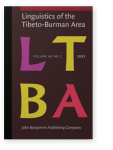Vol. 46:2 (2023) ► pp.165–200
Verb stem alternations in Pingwu Baima
This paper focuses on stem alternations in Pingwu Baima (Tibetic). It examines a larger corpus of data than the corpora in previous works and systematically relates alternating verbs to classical WT paradigms. Our data reveal a relatively high number of alternating verbs in Baima, with verbs with two stems constituting the absolute majority of all alternating verbs. A systematic comparison of alternating verbs to classical WT paradigms confirms that stem alternations in Baima regularly reflect OT verb morphology. Such a comparison also reveals a clear tendency toward elimination in Baima of a separate imperative stem of classical paradigms. This tendency toward elimination of the imperative stem has not been commonly reported in modern Tibetic languages. An examination of Baima verb stem alternation in the context of its neighboring Tibetic and non-Tibetic varieties suggests language contact as a possible trigger for this development.
Article outline
- 1.Introduction
- 2.Data and methodology
- 3.Morphology of verb alternation in Baima
- 4.Baima verb stem alternation in the context of the neighboring non-Tibetic varieties
- 5.Summary and conclusion
- Acknowledgements
- Notes
-
References
